CAPTIONS: all photos taken by Field School

Select on photograph to enlarge
Author, Stephanie examines a small artifact found in a bucket of excavated soil.
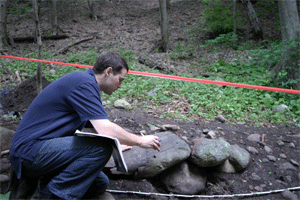
Select on photograph to enlarge
Cameron draws what remains of the western wall of the Pond.
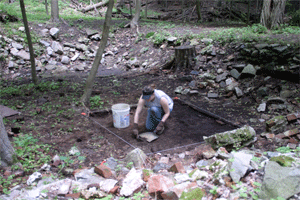
Select on photograph to enlarge
Vanessa helped begin another excavation unit inside the house in expectation of defining a brick feature discovered in 2005.
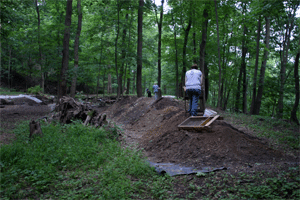
Select on photograph to enlarge
By the end of field school, the backdirt pile has grown to a significant height.
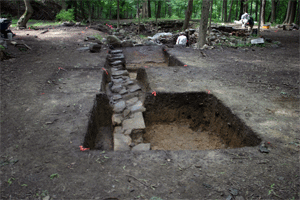
Select on photograph to enlarge
A foundation extends North of the house cellar and will be the target for additional excavations.

Select on photograph to enlarge
A close-up of one of the flume foundations at the Boring Mill.
|
Hi! My name is Stephanie Atwood, and I have just completed my first year of Michigan Tech’s IA Master’s Program. Not only is this my first summer at the WPF Field School, it marks my first experience with excavation as well. I have learned a great deal about archaeological methods and techniques, providing me with more confidence about my capabilities in the field.
Due to working last weekend for the Open House, we had Monday off, making our last week of Field School four days long. Despite this somewhat abbreviated timeframe, all of the students and professors put in a great deal of work. Joining us was Dr. Patrick Martin, director of the West Point Foundry Project and Professor of Archaeology at Michigan Tech. While visiting us, he served not only as an advisor to the students, but also as a liaison—meeting with members of the local community and giving tours during and after Open House. Everyone was able to benefit from his many years of experience in the field and his trained archaeological eye.
We also joined by a new volunteer, Stuart Johnson. Stuart has a background in architecture and historic preservation. He found out about the WPF project while working for an architectural firm in Dobbs Ferry that was involved in possible reuse plans for the Office Building. He feels that volunteering will give him a good introduction into archaeological work as well as a “snippet” of what Michigan Tech’s IA program entails. We hope that Stuart will join us in the Master’s Program at some point in the future and thank him for his hard work this week.
Work at the East Bank House continues to go extremely well. Cal and Stuart opened a new unit, 3.6A, at the interior SW corner of the house. A shovel test pit dug last year came down upon brick, and this unit will expose the brick enough to show if it served as a floor surface in the basement. The excavation has produced domestic hardware, such as door hinges, coat hooks, and window hardware, such as sash weights. Also inside the house, EU 3.7A, excavated by Nikki, was closed this week. I assisted her in mapping the intricate stonework of the foundation walls in her unit as well as the soil profiles. As a side note, this week’s work in the lab was devoted to the material that came out of her unit. All of the students spent their lab time working to complete this huge task. As a result, we can report that Level 1 contained 1,167 nails, Level 2 had 3,855 nails and 931 separate pieces of window glass. We can also report that, to date, we have processed at least 93 levels during Field School, which easily amounts to tens of thousands of artifacts.
Sam and Lindsay continued their work in EUs 2.7A and B by beginning to excavate the outside of the barrel feature. They are still working to reach the clay feature (74) that was excavated last year. Sam speculates that the barrel may have originally served as a household cistern, being buried in the ground with cobbles around it to form a sort of air pocket. This would contain a large amount of water that would then drain back into the barrel through holes to be pulled out as needed by the house’s occupants. But as there is no wood left from the barrel except for the bottom, they will have to continue excavation to see if this theory is correct.
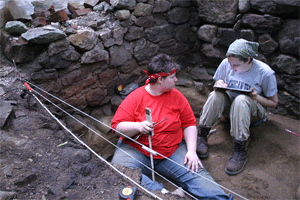
Select on photograph to enlarge
Nikki & Stephanie finish up a profile of an excavation unit inside the house. Notice the footer of the wall behind Nikki to the left.
While working in EUs 3.9 A and B, Shannon and Vanessa found some unique stains and gravel deposits in the soil. After examining them, Tim decided that they were to be labeled as features. We are still uncertain about what function of the iron slab in 3.9 B is, but we are now able to tell that it either preceded the or is contemporaneous with the cut stone wall (Feature 77), as the wall lies partially on top of it.
Down at the industrial core, Cameron and Dan began work on the S and SW end of the Battery Pond, removing all of the brush, leaves, and rubbish from its walls. At the SW end, a previously unknown wall running from the W end of the Pond was discovered and mapped. Also along the W wall, they dug a trench 8m long and 1m wide so as to clearly see the construction of the wall. Next week they will be mapping and taking final photographs. As they come to the final days of their project, they are reflecting on what they have learned this summer about the Pond, such as dating, function, and construction.
At the Boring Mill, Bode and Craig wrapped up the exposing of the W wall of the N room. They mapped in features from field observations and used total station data collected about a week ago. They also located and exposed original stone surfaces in the Boring room on the W side near the wheel pit. Finally, they clarified the nature of the machine base in E side of boring room. On Friday, they went through all the artifacts collected so far this season from the Boring Mill and created an inventory and photographs before their departure to Houghton.
As Field School draws to a close, I know that everyone can look back on what has been accomplished with a great deal of pride. All have worked very hard and pulled together in the field to study an amazing site that has and will continue to produce a great deal of information and excitement now and in the future.
Stephanie K. Atwood
|



